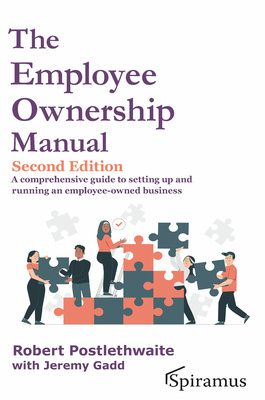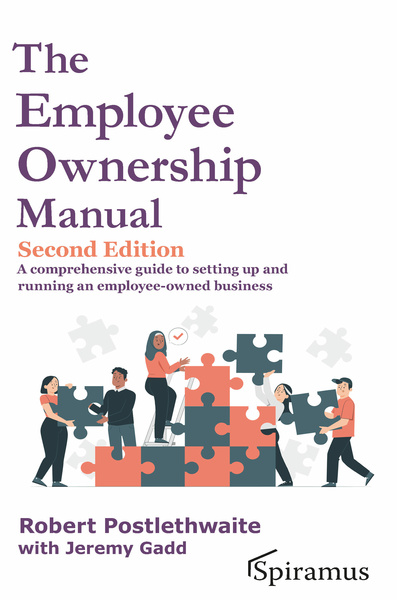The Employee Ownership Manual
A comprehensive guide to setting up and running an employee-owned business (second edition)
This book is intended to meet a range of different needs and to cater for different levels of knowledge about employee ownership. If you are considering making your company employee-owned or you are advising someone going through that process, and in either case are new to the topic, you can build up your knowledge levels from Chapter 1.
Alternatively, the book can be used as a reference work if you have a particular question to answer.
The book is intended as practical guide rather than a highly detailed technical treatise. Its priority is to explain key issues in an accessible fashion and to raise awareness of where further exploration and advice may be important.
Read more from the author on the new edition in this Q&A here.
- AvailablePaperback9781913507657248 pagesList Price: GBP 59.95 Add to basket
- AvailablePDF9781913507664248 pagesList Price: GBP 29.98 Add to basket
This book is intended to meet a range of different needs and to cater for different levels of knowledge about employee ownership. If you are considering making your company employee-owned or you are advising someone going through that process, and in either case are new to the topic, you can build up your knowledge levels from Chapter 1. Alternatively, the book can be used as a reference work if you have a particular question to answer.
Some parts of the book will not be relevant to every reader. For example, several Chapters consider how employees can acquire shares personally: these will not be relevant to companies which intend their employee ownership only to be through an employee trust.
The book is intended as a practical guide rather than a highly detailed technical treatise. Its priority is to explain key issues in an accessible fashion and to raise awareness of where further exploration and advice may be important.
Chapter 1 ‒ The background to employee ownership and why companies choose to become employee-owned is explored.
Chapter 2 ‒ Employee trusts are a key part of the structure of most employee-owned companies. Individual share ownership is also introduced here, as some employee-owned companies combine ownership by an employee trust (which usually holds the majority of the company’s shares) with direct, individual ownership of shares by employees.
Chapter 3 ‒ How employee trusts work and how the role of trustees as owners interacts with the role of the company’s directors is considered.
Chapter 4 ‒ The key steps and decisions that will need to be made in establishing an employee trust are considered.
Chapter 5 ‒ Individual share ownership, in particular the ways in which employees can acquire shares personally is looked at in more detail. This chapter also provides a summary of the tax reliefs that are available for individual employees acquiring shares in their company.
Chapter 6 ‒ Employee ownership trusts are a particular kind of employee trust, bringing particular tax reliefs. This chapter considers these tax reliefs and the various conditions which must be satisfied.
Chapter 7 ‒ Many companies become employee-owned through the existing owners transferring their shares to an employee trust. This chapter looks at how to plan ownership succession in this way and some key questions that will need to be considered.
Chapter 8 ‒ An employee ownership trust deed is likely to form the structural core of most employee-owned companies. This chapter explains the key provisions that it will commonly include.
Chapter 9 ‒ The people issues which arise in a transition to employee ownership are considered. This chapter has been written by Jeremy Gadd.
Chapter 10 ‒ The Share Incentive Plan (SIP) enables employees to purchase shares or receive free shares, in each case with relief against income tax. The SIP is an all-employee share scheme, which means that all employees must be allowed to participate in any offer of shares. This chapter looks at the statutory requirements for operating a SIP and how it works in practice.
Chapter 11 ‒ Save As You Earn (SAYE) options is another form of all-employee share scheme, under which employees can be granted options to acquire shares in the future and those employees who participate will save a monthly amount towards the option exercise price. This chapter considers how SAYE options work.
Chapter 12 ‒ Enterprise Management Incentive (EMI) options are considered. For companies wishing to create personal share ownership for their key people, EMI options will often be the best place to start. There are particular eligibility requirements for EMI options. These are considered in this chapter, which also discusses the key elements of an EMI scheme, and offers suggestions as to how EMI options can be structured.
Chapter 13 ‒ An alternative to EMI options is the Company Share Option Plan (CSOP). This chapter considers how the CSOP works.
Chapter 14 ‒ Other ways in which employees can acquire shares personally are looked at.
Chapter 15 ‒ Where employees are to acquire shares (or cash) from an employee trust, it is important to ensure that this is structured in a way which does not fall foul of tax anti-avoidance rules which were introduced to counter what is commonly referred to as disguised remuneration. This chapter looks at these provisions and how to keep on the right side of them. Failure to do so could result in a charge to income tax and National Insurance on the value of assets even though an employee has not acquired any definite ownership rights over them.
Chapter 16 ‒ This chapter sweeps up some other legal and regulatory matters not directly covered in previous chapters.
Chapter 17 ‒ Data protection requirements are covered.
Chapter 18 ‒ Phantom shares are considered.
Chapter 19 ‒ The interaction between corporation tax, employee trusts and different individual employee share schemes is covered.
Chapter 20 ‒ There are a number of registration and filing requirements with HM Revenue and Customs and the Registrar of Companies. This chapter considers these and some continuing administration requirements and summarises the accounting treatment of employee trusts and employee share schemes.
"I would strongly recommend The Employee Ownership Manual by Robert Postlewaite to any business owner exploring the transition to employee ownership. At the time of Oliver & Co’s move to employee ownership in October 2022, literature on the subject was scarce. This publication proved to be an invaluable resource in enhancing my understanding of employee ownership. Robert Postlewaite’s expertise is evident throughout, and his comprehensive guidance makes this manual an essential reference for anyone navigating this area”.
"Having explored exiting my business for a number of years I came across The Employee Ownership Manual and was hooked; finally finding a model that worked. I read the book from cover to cover, scribbling notes and highlighting so many sections; reading and re-reading as I went. 12 months later I am delighted to say we officially became an employee-owned business.
I can wholeheartedly recommend this book. It is easy to read, brings clarity to employee ownership and helps paint a clear picture in your mind of what employee ownership and business succession should look like. Having read it I had a clear plan of action, was able to identify the right model for us; and was able to make sure we developed reward and recognition schemes suitable for everyone once becoming employee owned.
I am not a legal or tax specialist and Robert’s book helped bridge that gap, explaining sometimes complex processes in a way that I could see clearly being implemented in the ‘real-world’.
I would 100% recommend this book to anyone thinking of exiting their business and not just those looking at employee-ownership. It will, I am sure bring clarity and focus as well as making you think long and hard about what is a fantastic business model when done well."
“The Ownership Dividend report of June 2018 identified a major barrier to the growth of employee ownership in the UK as a lack of awareness and understanding, not only amongst businesses which might want to take that route, but also amongst their professional advisers, financiers and investors. The publication of The Employee Ownership Manual is an important step towards removing that barrier.
Written by Robert Postlethwaite, a solicitor with a passion for employee ownership and many years’ experience advising on it, this will be a key resource not only for any company owner thinking about joining the UK’s fastest growing business sector, but also for accountants, lawyers and financiers who may not have encountered employee ownership before, but who – since the introduction of the Employee Ownership Trust in 2014 – are arguably negligent if they do not draw this tax effective option to the attention of clients seeking a succession plan for their business.
The Manual is comprehensive but accessible and simple to read, in a format which makes it easy to dip in and out of in order to find the information you need at any time. Whilst focussing mainly on all employee ownership (for the purposes of the book defined as an ownership stake for employees of at least 25%) it also covers the options for direct ownership of shares by employees, whether through tax approved schemes or otherwise, and includes useful sections on legal, regulatory and other tax points, as well as GDPR, registration, administration and accounting. But this is not a dry legal textbook - case studies, worked examples and illustrative tables bring the subject to life and the inclusion of a Glossary debunks the mystery of employee ownership for the lay reader. A section written by Jeremy Gadd of J.Gadd Associates offers invaluable insight and advice on the all-important people side of moving to employee ownership, without which even the best laid plans for employee ownership may fail.
Employee ownership is increasingly high on the agenda of all political parties, is regarded as a better and more productive way of doing business and is seen by many as the entry point to an alternative model of capitalism. This important book will promote and support that process, and encourage and enable more companies to become employee owned.”


